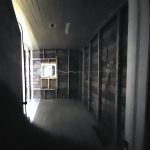I generally take pics of everything I do to keep a record of stuff. Today’s big task was re-routing electrical wires. The previous person had 16 objects on one 15-Amp circuit. To me, 10 is about maximum, and they would be mixed within various rooms. These 16 were mostly in one bedroom, the living room, and the bath. As well, they mixed lights with receptacles (outlets), a no-no in today’s practices. I cut the circuit in half, ran a new 14-2 wire from a new breaker to the second half of the circuit in question (living room, now total 8 items), added four extra receptacles to the original one (total 9 items), and cut the lights from this circuit, adding them to another light-dedicated breaker. Sorry, no pics. Maybe later. Late night. I got home 15 minutes before the New Year celebration on TV (CBC, I think).
Also, a partition wall between the hall and the stairway leading to the 2nd story suite was taken down. Not to code! A fire-rated wall will be put in its place.

I also found my notes from the last renovation four years ago.


















